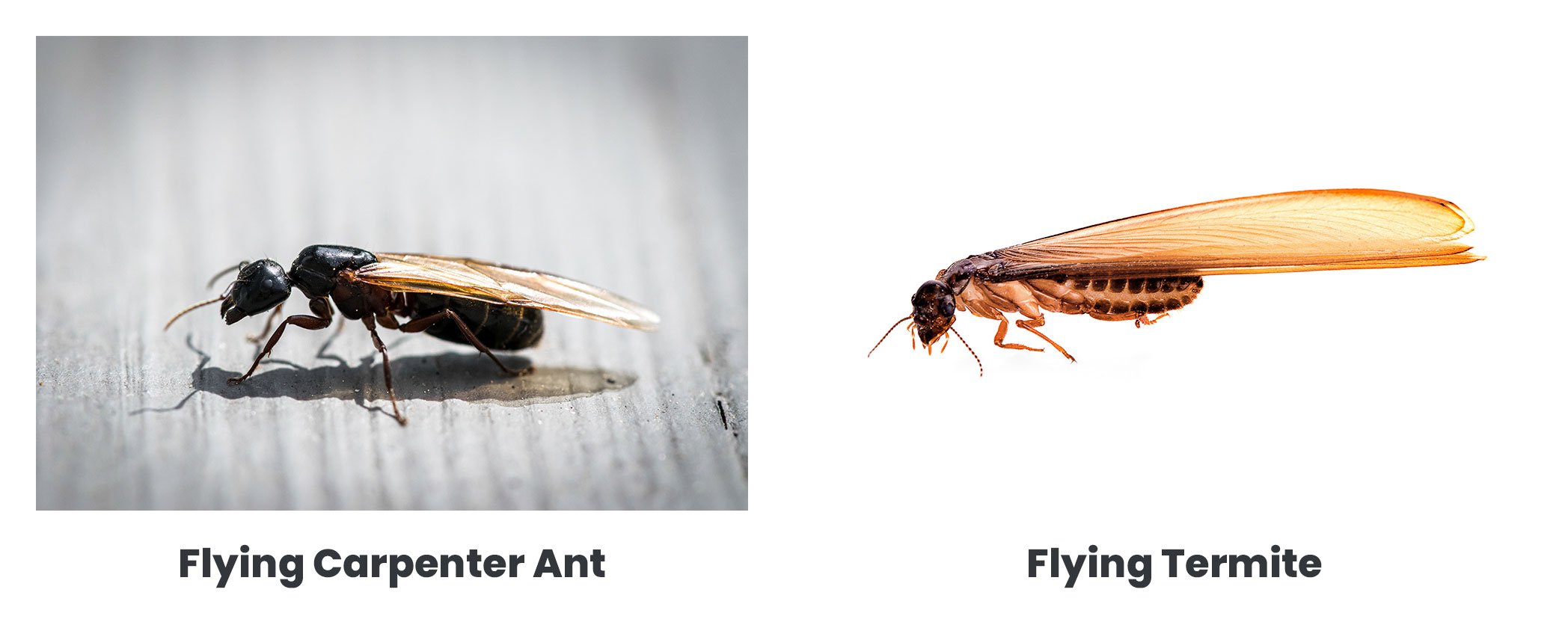
Spotting a swarm of small, winged insects around your home can be alarming—but are they termites or ants? While these pests might look similar at first glance, they behave very differently and pose very different risks to your home.
Knowing how to tell the difference between termites and ants can save you time, money, and major headaches. In this post, we’ll break down the key physical and behavioral differences, explain why it matters, and help you understand what to do if you find either in your home.
Why It’s Important to Know the Difference
Both ants and termites can swarm in large numbers, especially during warmer months. However, only one of them is capable of causing thousands of dollars in structural damage: termites.
Carpenter ants can also damage wood, but termites eat it as a food source—leading to much more widespread destruction. Misidentifying one for the other can delay treatment and allow an infestation to grow unchecked.
Key Physical Differences: Termites vs. Ants
Here’s how you can quickly tell the two apart with a closer look:
| Feature | Termites | Ants |
| Body Shape | Straight waist | Narrow waist (pinched or segmented) |
| Antennae | Straight, beaded | Bent or “elbowed” |
| Wings | Two equal-sized pairs (all four same size) | Two pairs; front wings larger than back wings |
| Color | Creamy white to light brown (workers) | Typically black, brown, or red |
Pro Tip: Termite wings often fall off easily and can be found near windowsills. Finding piles of discarded wings indoors is a major red flag for termite activity.
Behavioral Differences
Physical traits are just one part of the puzzle. Termites and ants behave differently, and their habits can offer clues as to which pest you’re dealing with.
Termite Behavior
- Eat wood and cellulose-based materials.
- Build mud tubes for protection while traveling.
- Prefer dark, moist, and hidden areas.
- Swarm typically once per year—often in spring.
Ant Behavior
- Eat a wide variety of foods (especially sugars and proteins).
- Follow visible trails toward food sources.
- Nest in walls, soil, under concrete, or in wood (carpenter ants).
- Swarm in response to colony growth or warm weather.
Signs of Termite Infestation
- Mud tubes on walls, foundation, or crawl spaces.
- Hollow-sounding wood when tapped.
- Frass (termite droppings that look like small wood pellets).
- Discarded wings near doors or windows.
- Blistering or buckling wood or paint.
Termites often go unnoticed until significant damage is done, as they work silently and stay hidden.
Signs of Ant Infestation
- Visible trails of ants leading to food or water.
- Mounds of dirt near foundations or sidewalks.
- Rustling noises inside walls (carpenter ants).
- Sawdust piles near wooden structures (also carpenter ants).
- Live or dead ants appearing consistently indoors.
Ants are usually easier to spot since they’re more likely to forage in the open.
Carpenter Ants vs. Termites
If you suspect wood damage, there’s a chance you’re dealing with carpenter ants, not termites. While both pests damage wood, their methods differ:
- Termites eat wood, weakening the structure from the inside out.
- Carpenter ants excavate wood to build nests, pushing the debris (frass) out of tunnels.
This distinction is important for treatment and repair strategies.
Why Fast Identification and Action Matters
A termite colony can eat through key structural components of your home silently, causing significant damage before you even realize they’re there. Meanwhile, an unchecked ant infestation—especially carpenter ants—can grow rapidly and become a constant nuisance.
Waiting too long to act means higher repair costs and more extensive treatments. That’s why professional inspection is always recommended at the first sign of swarming or structural damage.
What to Do If You Find Swarming Insects
- Don’t panic. Take photos or collect a sample (in a sealed container).
- Note where you found them. Indoors? Near wood? In soil?
- Don’t spray immediately. Over-the-counter sprays may kill visible insects but scatter the colony, making treatment harder.
- Call a licensed pest control company. Professionals can accurately identify the species and recommend safe, effective treatment.
Final Thoughts
Seeing winged insects in or around your home can be concerning, but knowing whether you’re dealing with ants or termites is crucial. With careful observation—or better yet, a professional inspection—you can get to the root of the issue quickly and take appropriate action.
If you’re unsure what kind of pest you’re dealing with, don’t take chances. The cost of inaction with termites, in particular, can be devastating. A pest control expert can provide peace of mind and a path toward a pest-free home. We recommend pest control in new york.
